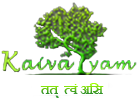Asanas – Introduction
Asanas are specific body positions which open the energy channels and psychic centres. They are tools to higher awareness and provide the stable foundation for our exploration of the body, breath, mind and beyond.
In the Yoga Sutras of Patanjali there is a concise definition of yogasanas: “Sthiram sukham aasanam”, meaning that position which is comfortable and steady.

Asanas – Classification and types
The asanas are classified into three groups: Beginners, intermediate and advance.
Beginners Group should be performed by new practitioners. It consist of elementary techniques to prepare the body and mid for higher level. Included in this group are the pawanmuktasana series, eye exercises, relaxation, meditation poses, asanas performed from vajrasana, standing asanas and surya namaskara.
Pawanmuktasana Part 1 – Also called as anti-rheumatic group, it is concerned with releasing tensions from the joints of the body. The list of asanas are Padanguli naman (toe bending), Goolf naman (ankle bending), Goolf chakra (ankle rotation), Goolf ghoornam (ankle crank), Janufalak akarshan (kneecap contraction), Janu naman (knee bending), Janu chakra (knee crank), Ardha titali asana (half butterfly), Shroni chakra (hip rotation), Poorna titali asana (full butterfly), Mushtika bandhana (hand clenching), Manibandha naman (wrist bending), Manibandha chakra (wrist joint rotation), Kehuni naman (elbow bending), Kehuni chakra (elbow rotation), Skandha chakra (shoulder socket rotation) and Greeva sanchalana (neck movements).
Pawanmuktasana Part 2 – A group specifically for strengthening the digestive system with elimination of energy blockages in the abdominal area. The list of asanas are Padotthanasana (raised legs pose), Padachakrasana (leg rotation), Pada sanchalanasana (cycling), Supta pawanmuktasana (leg lock pose), Jhulana lurhakanasana (rocking and rolling), Supta udarakarshanasana (sleeping abdominal stretch pose), Shava udarakarshanasana (universal spinal twist) and Naukasana (boat pose).
Pawanmuktasana Part 3 – This group of asanas is concerned with improving the energy flow within the body and breaking down neuro-muscular knots. The list of asansa are Rajju Karshanasana (putting the rope), Gatyatmak menu vakrasana (dynamic spinal twist), Chakki chalanasana (churning the mill), Nauka sanchalanasana (rowking the boat), Kashtha Takshanasana (chopping wood), Namaskarasana (salutation pose), Vayu Nishkasana (wind releasing pose), Kauva chalasana (crow walking) and Udarakarshanasana (abdominal stretch pose).
Eye exercises – The most common eye disorders are functional defects in the ocular muscles. The list of following simple exercises help to alleviate various disorders like short and long-sightedness, presbyopia and squint.
Palming, Blinking, Front and sideways viewing, Up and down viewing, Rotational viewing, Preliminary nasikagra drishti (preliminary nosetip gazing) and Near and distant viewing.
Relaxation asanas – Constant postural abnormalities and tiredness can be overcome by performing relaxation asanas which work consciously on all the muscles of the body . They should be performed before and after asanas. The list includes Shavasana (corpse pose), Advasana (reversed corpse pose), Jyestikasana (superior posture), Makarasana (crocodile pose) and Matsya Kridasana (flapping fish pose).
Meditation asanas – The purpose of this group of asanas to allow to sit for extended periods of time without moving the body and without discomfort. The list of asanas are Sukhasana (easy pose), Ardha padmasana (half lotus pose), Padmasana (lotus pose), Siddhasana (accomplished pose for men), Siddha yoni asana (accomplished pose for women), Swastikasana (auspicious pose) and Dhyana veerasana (hero’s meditation pose).
Vajrasana asanas – This group of asanas leads to control of vajra nadi which is directly connected with the genito-urinary system. The list includes Vajrasana (thunderbolt pose), Ananda madirasana (intoxicating bliss pose), Padadhirasana (breath balancing pose), Bhadrasana (gracious pose), Simhasana (lion pose), Simhagarjanasana (roaring lion pose), Veerasana (hero’s pose), Marjari-asana (cat stretch pose), Vyaghrasana (tiger pose), Shashankasana (hare pose), Shashank bhujangasana (striking cobra pose), Naman pranamasana (postration pose), Ashwa sanchalanasana (equestrian pose), Ardha ushtrasana (half camel pose), Ushtrasana (camel pose) and Supta vajrasana (sleeping thunderbolt pose).
Standing asanas – This series has a stretching and strengthening effect on the back, shoulders and leg muscles. The list has Bandha hasta utthanasana (locked hadn raising pose), Akarna dhanurasana (bow and arrow pose), Tadasana (palm tree pose), Tirkaya tadasana (swaying palm tree pose), Kati chakarasana (waist rotating pose), Tirkaya kati chakarasana (swaying waist rotating pose), Meru prishthasana (spine and back pose), Utthanasana (squat and rise pose), Druta utkatasana (dynamic energy pose), Dwikonasana (double angle pose), Trikonasana (triangle pose), Utthita lolasana (swinging while standing pose) and Dolasana (pendulum pose).
Surya Namaskara – Or Sun Salutation, a Vedic ritual solemnized in the early morning, combines seven different postures. Surya or Sun, the life generator is invoked by this Yogic exercise – an easy way to keep fit. The twelve step to perform are as follows.

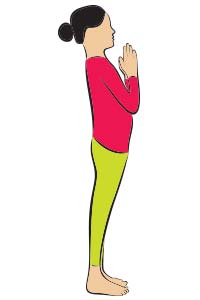
STEP ONE:
Pranamasana(Prayer pose)
Stand facing the direction of the sun with both feet touching. Bring the hands together, palm-to-palm, at the heart.
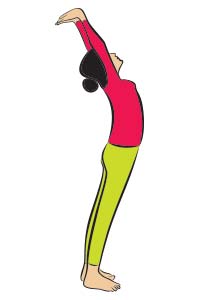
STEP TWO:
Hasta Utthanasana (raised arms pose)
Inhale and raise the arms upward. Slowly bend backward, stretching arms above the head.
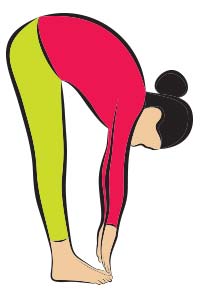
STEP THREE:
Padahastasana (hand to foot pose)
Exhale slowly bending forward, touching the earth with respect until the hands are in line with the feet, head touching knees.
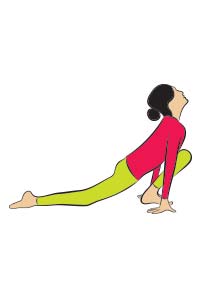
STEP FOUR:
Ashwa Sanchalanasana (equestrian pose)
Inhale and move the right leg back away from the body in a wide backward step. Keep the hands and feet firmly on the ground, with the left foot between the hands. Raise the head.
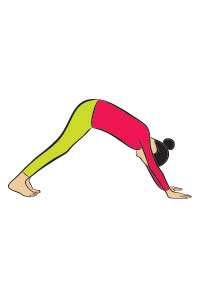
STEP FIVE:
Parvatasana (mountain pose)
While exhaling, bring the left foot together with the right. Keep arms straight, raise the hips and align the head with the arms, forming an upward arch.
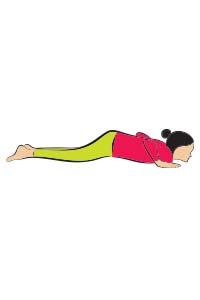
STEP SIX:
Ashtanga Namaskara (eight parts salute)
Exhale and lower the body to the floor until the the feet, knees, hands, chest, and forehead are touching the ground.
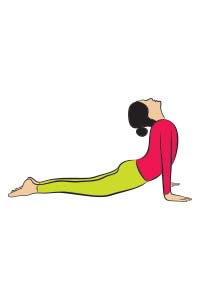
STEP SEVEN:
Bhujangasana (cobra pose)
Inhale and slowly raise the head and bend backward as much as possible, bending the spine to the maximum (as in the naga-asana).
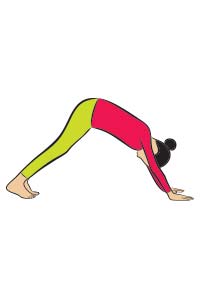
STEP EIGHT:
Parvatasana (mountain pose)
While exhaling, bring the left foot together with the right. Keep arms straight, raise the hips and align the head with the arms, forming an upward arch.
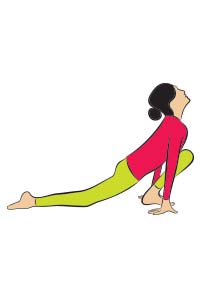
STEP NINE:
Ashwa Sanchalanasana (equestrian pose)
Inhale and move the right leg back away from the body in a wide backward step. Keep the hands and feet firmly on the ground, with the left foot between the hands. Raise the head.
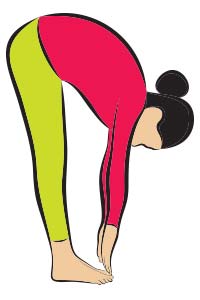
STEP TEN:
Padahastasana (hand to foot pose)
Exhale slowly bending forward, touching the earth with respect until the hands are in line with the feet, head touching knees.
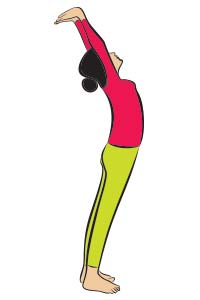
STEP ELEVEN:
Hasta Utthanasana (raised arms pose)
Inhale and raise the arms upward. Slowly bend backward, stretching arms above the head.
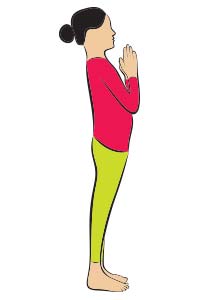
STEP TWELVE:
Pranamasana (Prayer pose)
Stand facing the direction of the sun with both feet touching. Bring the hands together, palm-to-palm, at the heart.
